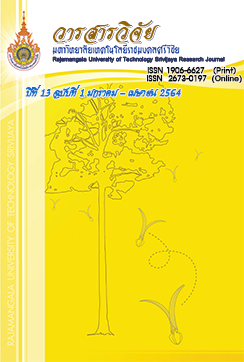The Synthetic Pathways of a New 1,2,3-Triazole-Containing Sorafenib Analogue and Its Cytotoxicity towards Cancer Cell Lines
Keywords:
sorafenib analogue, 1,2,3-triazole, cytotoxicity towards cancer cell lines, multikinase inhibitor, click reactionAbstract
Sorafenib (1) is a targeted cancer drug, which was approved by the Food and Drug Administration of the United States (US FDA) for the treatment of advanced hepatocellular carcinoma, renal cell carcinoma and thyroid carcinoma. In addition, sorafenib shows ability to inhibit various cancer cell lines due to its multikinase-inhibitory activity. However, sorafenib exhibits several disadvantageous pharmacological properties resulting in many adverse effects. Hence, many researchers are interested in design and synthesis to overcome the problems, and to search for their anti-tumor activities. Herein, the triazole-containing sorafenib analogue 2 was successfully synthesized by two different pathways. In the former pathway, 1,2,3-triazole ring was constructed via click reaction followed by aryl urea formation, which was suitable for the synthesis of analogues 14 with various substituted aryl moieties. The latter pathway started with linking aryl with urea and then click reaction for the triazole ring generation which was suitable for the synthesis of analogue 2 and the serial preparation of the substituted benzyl analogues 15. The study of biological activities towards cancer cell lines using MTT assay revealed that analogue 2 were inactive against MOLT-3, A549 and HuCCA-1 with IC50 > 100 µM. However, the obtained evidences will be an important guideline for the syntheses of the aryl- and benzyl-substituted analogues 14 and 15, which can be potentially active towards various cancer cell lines including liver cancer cell lines.
References
Bayer Health Care Pharmaceuticals Inc. 2010. Patient Information: NEXAVAR® (NEX-A-VAR) (sorafenib) tablets, oral. Available Source: https://www.accessdata.fda.gov/drugsatfda_docs/label/2010/021923s008s009lbl.pdf, October 4, 2019.
Cheng, A.L., Kang, Y.K., Chen, Z., Tsao, C.J., Qin, S., Kim, J.S., Luo, R., Feng, J., Ye, S., Yang, TS., Xu, J., Sun, Y., Liang, H., Liu, J., Wang, J., Tak, W.Y., Pan, H., Burock, K., Zou, J., Voliotis, D. and Guan, Z. 2009. Efficacy and safety of sorafenib in patients in the Asia-Pacific region with advanced hepatocellular carcinoma: a phase III randomised, double-blind, placebo-controlled trial. Lancet Oncology 10(1): 25-34.
Džolić, Z.R., Perković, I., Pavelić, S.K., Sedić, M., Ilić, N., Schols, D. and Zorc, B. 2016. Design, synthesis, and cytostatic activity of novel pyrazine sorafenib analogs. Medicinal Chemistry Research 25(12): 2729-2741.
Guo, Z., Yan, Z., Zhou, X., Wang, Q., Lu, M., Liu, W., Zhou, H., Yang, C. and McClain, E.J. 2015. Synthesis and biological evaluation of novel 1,2-benzisothiazol-3-one-derived 1,2,3-triazoles as caspase-3 inhibitors. Medicinal Chemistry Research 24(5): 1814-1829.
Hansen, T.V., Wu, P., Sharpless, W.D. and Lindberg, J.G. 2005. Just Click It: Undergraduate Procedures for the Copper(I)-Catalyzed Formation of 1,2,3-Triazoles from Azides and Terminal Acetylenes. Journal of Chemical Education 82(12): 1833-1836.
Intaraprasong, P. 2018. New therapy including combination. Thai Journal of Hepatology 1(2): 33-36. (in Thai)
International Agency for Research on Cancer. 2019. All cancers. Global Cancer Observatory. Available Source: http://gco.iarc.fr/today/data/factsheets/cancers/39-All-cancers-fact-sheet.pdf, March 15, 2019.
Khandan, M., Rizi, S.S., Khodarahmi, G. and Hassanzadeh, F. 2018. Synthesis and cytotoxic evaluation of some novel quinoxalinedione diarylamide sorafenib analogues. Research in Pharmaceutical Sciences 13(2): 168-176.
Kong, X., Yao, Z., He, Z., Xu, W. and Yao, J. 2015. Design, synthesis and biological evaluation of thiourea and nicotinamide-containing sorafenib analogs as antitumor agents. Medicinal Chemistry Communications: 6(5): 1-5.
Stoddart, M.J. 2011. Mammalian Cell Viability Method and Protocols. Humana Press, New York. doi: 10.1007/978-1-61779-108-6.
Sun, S., He, Z., Huang, M., Wang, N., He, Z., Kong, X. and Yao, J. 2018a. Design and discovery of thioether and nicotinamide containing sorafenib analogs as multikinase inhibitors targeting B-Raf, B-RafV600E and VEGFR
-2. Bioorganic and Medicinal Chemistry 26(9): 2381-2391.
Sun, S., Zhang, J., Wang, N., Kong, X., Fu, F., Wang, H., and Yao, J. 2018b. Design and Discovery of Quinazoline- and Thiourea-Containing Sorafenib Analogs as EGFR and VEGFR-2 Dual TK Inhibitors. Molecules 23(24): 1-14.
Wilkening, I., Signore, G.D. and Hackenberger, C.P.R. 2011. Synthesis of Phosphonamidate Peptides by Staudinger Reactions of Silylated Phosphinic Acids and Esters. Chemical Communication 47: 349-351.
Yao, J., He, Z., Chen, J., Chen, D., Sun, W. and Xu, W. 2012. Design, Synthesis and Antiproliferative Activities of Diaryl Thiourea Derivatives as Anticancer Agents. Chinese Journal of Chemistry 30(10): 2423-2430.
Downloads
Published
How to Cite
Issue
Section
License
The content and information in the article published in Journal of Rajamangala University of Technology Srivijaya It is the opinion and responsibility of the author of the article. The editorial journals do not need to agree. Or share any responsibility.







